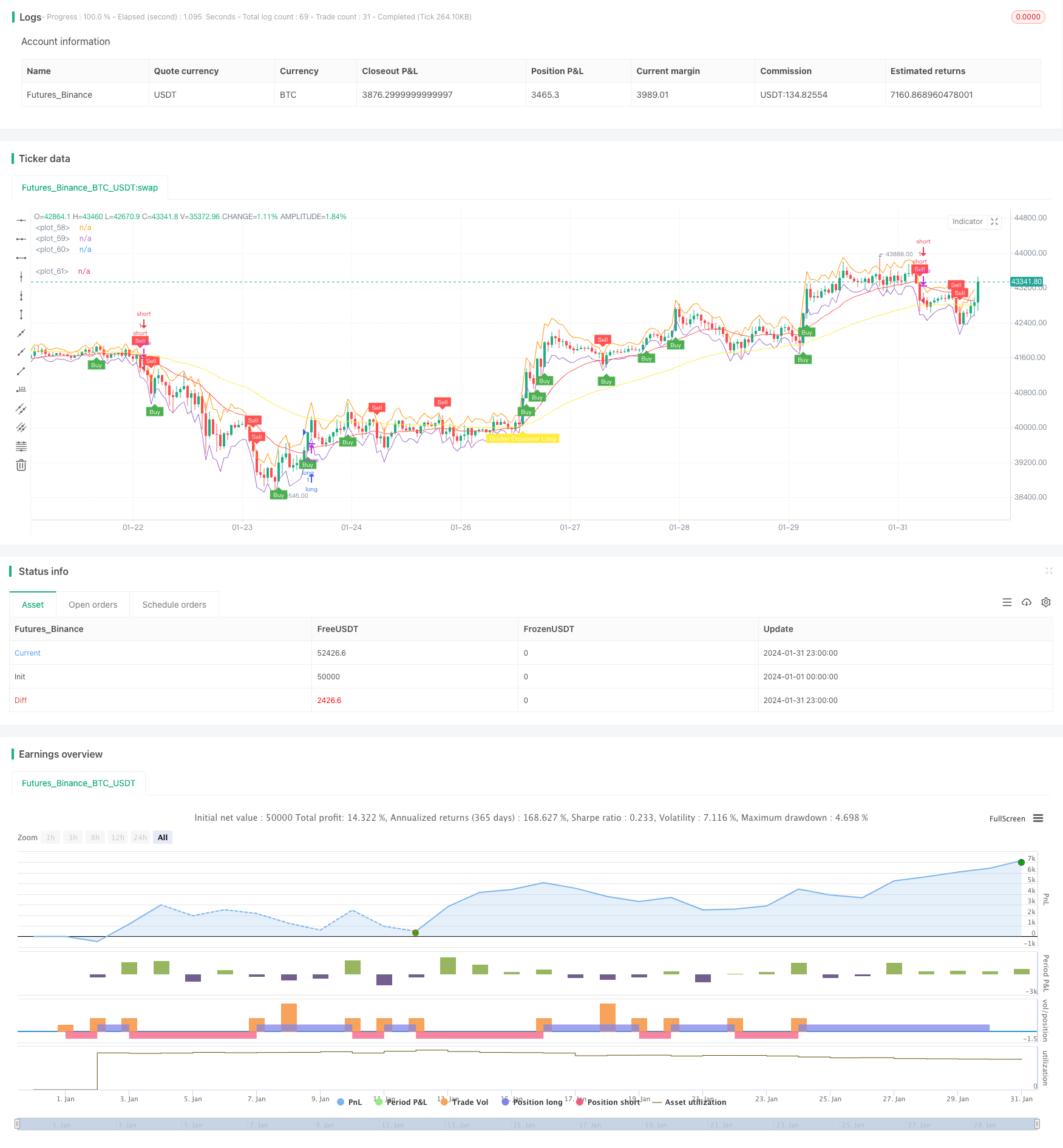ゲムフォレスト"分スケーリング戦略
作者: リン・ハーンチャオチャン, 開催日:2024年2月19日 10:45:18タグ:

概要
Gem Forest One Minute Scalping Strategyは,短期取引のための定量的な取引戦略である.これは,複数の指標を組み合わせて,1分間のタイムフレーム内で市場振動の特徴を特定し,超ショート・スカルピングのためのロング・ショート・ポジションを切り替える.
戦略の論理
- ATRインジケーターは,価格振動範囲を決定するために上位および下位帯を構築します.
- EMAの速さと遅さのクロスオーバーが取引信号を生成する
- 2つのRSI指標がクロスオーバー信号を確認
- 入口と出口点は,指標信号と価格レベルを組み合わせることで決定されます.
価格が下帯を下回ると,速いEMAと遅いEMAの黄金十字が起こり,速いRSIがスローRSIを超越すると,買い信号が生成される.価格が上帯を下回ると,速いEMAと遅いEMAの死十字が起こり,速いRSIがスローRSIを下回ると,売り信号が生成される.エントリー後,ストップ損失と取利益が出口に使用される.
利点分析
- 多数の指標を組み合わせることで信頼性が向上します
- 高頻度で稼働することで 利益の獲得の可能性が高まる
- 減量,安定性
- 超短スケープを1分以内またはそれより短時間で行うことができる.
リスク分析
- 高周波によるネットワークとハードウェアの要求が高くなる
- 過剰取引および資本分散リスク
- インディケーターの設定が不適切であるため,誤った信号
- リスク・リスク・リスク・リスク・リスク・リスク
これらのリスクは,パラメータを最適化し,ストップを調整し,最大日取引を制限し,適切な製品を選択することによって管理できます.
オプティマイゼーションの方向性
- 異なるATR期間の試験影響
- 異なるEMAタイプを試すか,EMAを1つ置き換えるか
- RSI期間を調整したり,KDJ,ストキャスティックスなどの他の振動計をテストしたりします.
- トレンドのようなより多くの要因でエントリーロジックを改善
- より良いリスク/報酬比のためにストップを最適化
結論
この戦略は,超短期間量的な取引の特徴を完全に考慮している.合理的な指標設定,複数の確認および組み合わせは高い信頼性を保証する.厳格なリスク管理により,かなりの利益の可能性があり,十分なコンピューティングパワーと心理的品質を持つ投資家に適している.
/*backtest
start: 2024-01-01 00:00:00
end: 2024-01-31 23:59:59
period: 1h
basePeriod: 15m
exchanges: [{"eid":"Futures_Binance","currency":"BTC_USDT"}]
*/
//@version=5
strategy("Gem Forest 1 Dakika Scalp", overlay=true)
source = close
atrlen = input.int(14, "ATR Period")
mult = input.float(1, "ATR Multi", step=0.1)
smoothing = input.string(title="ATR Smoothing", defval="WMA", options=["RMA", "SMA", "EMA", "WMA"])
ma_function(source, atrlen) =>
if smoothing == "RMA"
ta.rma(source, atrlen)
else
if smoothing == "SMA"
ta.sma(source, atrlen)
else
if smoothing == "EMA"
ta.ema(source, atrlen)
else
ta.wma(source, atrlen)
atr_slen = ma_function(ta.tr(true), atrlen)
upper_band = atr_slen * mult + close
lower_band = close - atr_slen * mult
ShortEMAlen = input.int(21, "Fast EMA")
LongEMAlen = input.int(65, "Slow EMA")
shortSMA = ta.ema(close, ShortEMAlen)
longSMA = ta.ema(close, LongEMAlen)
RSILen1 = input.int(25, "Fast RSI Length")
RSILen2 = input.int(100, "Slow RSI Length")
rsi1 = ta.rsi(close, RSILen1)
rsi2 = ta.rsi(close, RSILen2)
atr = ta.atr(atrlen)
RSILong = rsi1 > rsi2
RSIShort = rsi1 < rsi2
longCondition = open < lower_band
shortCondition = open > upper_band
GoldenLong = ta.crossover(shortSMA,longSMA)
Goldenshort = ta.crossover(longSMA,shortSMA)
plotshape(shortCondition, title="Sell Label", text="Sell", location=location.abovebar, style=shape.labeldown, size=size.tiny, color=color.red, textcolor=color.white, transp=0)
plotshape(longCondition, title="Buy Label", text="Buy", location=location.belowbar, style=shape.labelup, size=size.tiny, color=color.green, textcolor=color.white, transp=0)
plotshape(Goldenshort, title="Golden Sell Label", text="Golden Crossover Short", location=location.abovebar, style=shape.labeldown, size=size.tiny, color=color.blue, textcolor=color.white, transp=0)
plotshape(GoldenLong, title="Golden Buy Label", text="Golden Crossover Long", location=location.belowbar, style=shape.labelup, size=size.tiny, color=color.yellow, textcolor=color.white, transp=0)
if (longCondition)
stopLoss = low - atr * 2
takeProfit = high + atr * 5
strategy.entry("long", strategy.long, when = RSILong)
if (shortCondition)
stopLoss = high + atr * 2
takeProfit = low - atr * 5
strategy.entry("short", strategy.short, when = RSIShort)
plot(upper_band)
plot(lower_band)
plot(shortSMA, color = color.red)
plot(longSMA, color = color.yellow)
もっと
- イチモク・クラウド・ナイン戦略
- LPB マイクロサイクルの適応性振動コンタール追跡戦略
- ストップ・ロストとテイク・プロフィート・トラッキングの最良の ABCD パターン・トレーディング戦略
- 主要トレンド指標 長
- 複数の時間枠戦略
- 動的バランス・レバレッジETF投資戦略
- マックド指標のクロスオーバー取引戦略
- ゲムフォレスト 1分脱出戦略
- 3つの高いキャンドルの逆転戦略
- MACD 移動平均 組み合わせクロスペリオド 動的トレンド戦略
- シグナルスムージング エーラーズ サイバーサイクル戦略
- 取引戦略をフォローするEMAのクロスオーバートレンド
- トレンド フォロー ストラテジー ろうそくの方向性に基づく
- 双重確認MACDとRSI戦略
- ウィリアムズ・ダブル指数関数移動平均とイチモク・キンコウ・ヒョー戦略
- 3 10 オスイレータープロフィールのフラグ・戦略
- 長期間のRSI-SRSI取引戦略
- MACD と RSI との組み合わせた戦略
- ATR,EOM,VORTEXをベースにした長期トレンド戦略
- 双動平均のスマートトラッキング・トレード戦略